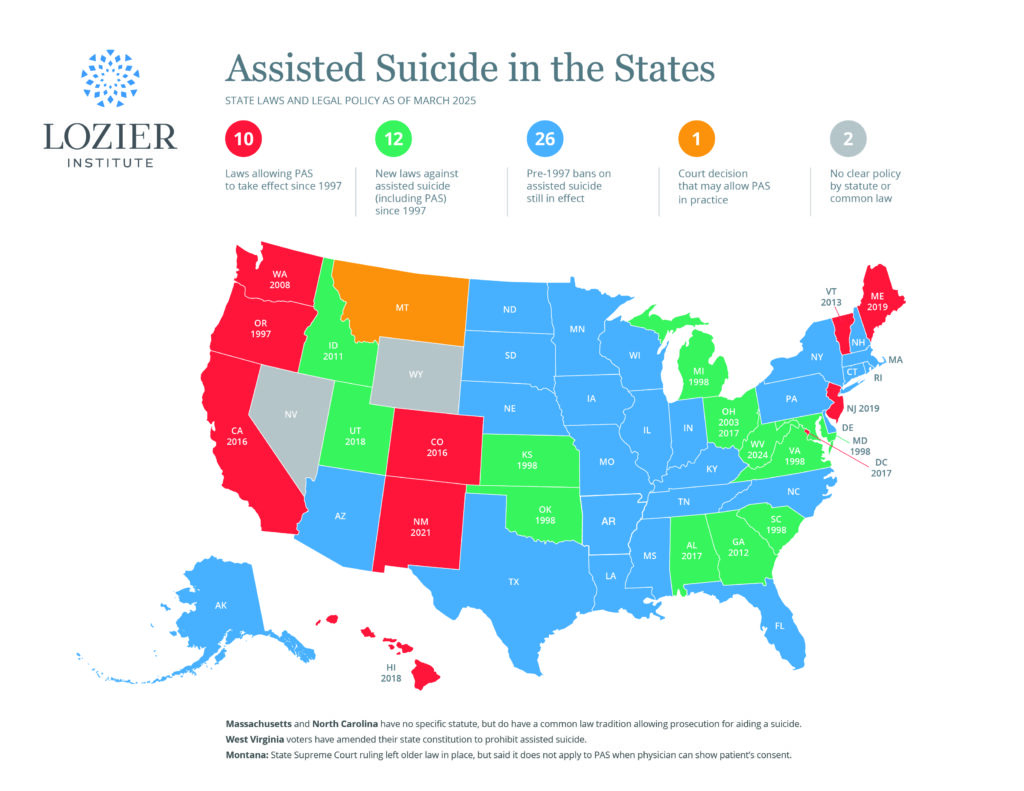A Reality Check on Assisted Suicide in Oregon
This is Issue 15 of the On Point Series.
Executive Summary
The group “Compassion & Choices” (C&C) promotes Oregon’s state law allowing physician-assisted suicide as a model for the nation, claiming: “Almost two decades of rigorously observed and documented experience in Oregon shows us the law has worked as intended, with none of the problems opponents had predicted.” The evidence shows otherwise:
- All reporting of cases is by the physician who prescribed the lethal drug overdose, with no allowance for independent scrutiny; even death certificates are falsified to prevent such scrutiny.
- The vast majority of patients receive no psychological or psychiatric evaluation. The law allows assisted suicide for patients with depression or other mental disturbance, if the doctor feels that their condition has not led to “impaired judgment.”
- There is seldom a health professional present, and never an assessment of competency, psychological conditions or freedom from coercion, when the drugs are taken.
- Conditions qualifying a patient for the lethal prescription have grown to include cases of chronic illnesses, benign tumors, and sometimes no reported illness at all.
- Predictions that a patient will die within six months have proven highly unreliable, and like other actions by the physician need only be done “in good faith,” allowing actions that in other medical contexts would show negligence.
- Assurances of a quick and “painless” death have also proved unreliable.
- The law does not clearly require that the patient self-administer the lethal dose; in practice others may take an active role, and even health professionals who directly kill patients are not prosecuted.
- The pressures on patients include a state policy of reimbursing for assisted suicide but not for treatments that may sustain life.
- Despite a reporting system designed to conceal rather than detect problems, news of individual abuses has leaked out that may be only the tip of the iceberg.
Introduction
Compassion & Choices (formerly the Hemlock Society), the nation’s most prominent advocate for legalizing assisted suicide for seriously ill patients, claims that experience in Oregon demonstrates that such “medical aid in dying” is a safe and well-regulated procedure. According to its fact sheet:
“Medical aid in dying is a safe and trusted medical practice because the eligibility requirements ensure that only mentally capable, terminally ill adults with a prognosis of six months or less who want the choice of a peaceful death are able to request and obtain aid-in-dying medication…. Almost two decades of rigorously observed and documented experience in Oregon shows us the law has worked as intended, with none of the problems opponents had predicted.”[1]
In fact, even the official data collected by Oregon’s health department indicate otherwise, and independent sources confirm that the “safeguards” hailed by C&C do not prevent abuse.
“Rigorously observed and documented”?
Reporting to the state is done solely by the physician prescribing the lethal drugs, who has every incentive to report that all is well. The Oregon Health Division has admitted that a doctor’s account “could have been a cock-and-bull story,” adding that “we cannot detect or accurately comment on issues that may be under reported.”[2]
At the time when the patient actually ingests the drugs and dies, this physician is not present in 90% of known cases; in 80% of known cases, no health care provider is present to observe.[3]
Physicians’ reports are destroyed after the state does its annual statistical review.[4]
Death certificates are falsified to report the underlying illness as the cause of death. [5] Yet the Oregon Health Department acknowledges that its reports include “the number of people for whom DWDA [Death with Dignity Act] prescriptions were written (DWDA recipients) and the resulting deaths from the ingestion of the medications (DWDA deaths).”[6] Death certificates are falsified to avoid autopsy or other scrutiny.
Physicians and others are exempt from liability if they act “in good faith” — the lowest legal standard, allowing actions that are negligent.[7]
Only “mentally capable” patients without depression or other mental disturbance?
Whether to request a psychological or psychiatric evaluation is optional for the physician. Over 96% of patients are given the lethal drugs without such evaluation.[8]
The law provides for such evaluation only when the patient “may be suffering from a psychiatric or psychological disorder or depression causing impaired judgment.” This allows giving the lethal drugs even to patients with clinical depression if the doctor decides the depression is a “normal” reaction to serious illness, and hence does not involve impaired judgment.[9]
Competency at the time the drugs are taken?
Proponents claim that obtaining the prescription for lethal drugs or the drugs themselves does not necessarily indicate a desire to die, that some patients are simply reassured that if their condition were to become unbearable they would have that option. This means that assessing competency and freedom from mental disturbance is most important at the time the drugs are actually taken, which could occur many months later. The Oregon law provides for no assessment or scrutiny at that decisive time.[10]
Only for “terminally ill adults with a prognosis of six months or less”?
Diagnoses that qualify patients for the drugs increasingly include less predictable conditions like chronic respiratory or cardiac disease, diabetes, etc. Even “benign and uncertain” tumors qualify.[11]
Since 1998 there have been three Oregon patients with no known illness at all.[12]
Nineteen patients who died from the drugs in 2016 (as well as seven in 2015 and 11 in 2014) had been diagnosed as having less than six months to live in previous years.[13]
Of the 90 patients who received prescriptions in 2016 but did not take the drugs, only 36 died that year of other causes.[14]
A sure and “peaceful” death?
In 2016, the drugs are known to have taken as long as nine hours to cause death (with this figure unknown in 81% of cases).[15] In 2009, at least one patient died 104 hours after ingesting the drugs.[16]
At least 30 patients in Oregon (three in 2016) have regurgitated some or all of the drugs. In all, six regained consciousness after taking them and died later. Five died from their underlying illness, and one patient in 2012 apparently died six days later from the effects of the drugs. No patient who has gone through this experience once seems ever to have tried again.[17]
The patient’s own “choice”?
Just as there is no assessment of competency at the time the drugs are actually ingested, there is no scrutiny to determine whether this is voluntary or coerced. Even the law’s provision for criminal penalties for coercing a patient or exerting undue influence apply only to the “request for medication,” not the later administration of the drugs.[18]
No provision of the Oregon law clearly requires that only the patient can administer the drugs; it does speak of the patient “ingesting” (swallowing or absorbing) the drugs. The Oregon attorney general’s office has said the state may have to allow other persons to administer them to patients with disabilities, to comply with laws such as the Americans with Disabilities Act.[19]
Seventy percent of the patients taking the drugs in 2016 (and 71% in 2015) had no or only governmental health insurance. Oregon’s state health plan provides full funding for “aid in dying,” while capping coverage for potentially life-supporting therapies, raising the specter of financial pressure toward assisted suicide.[20]
Troubling cases
The Oregon law creates a closed system in which all reporting is by those most directly involved, rendering scrutiny by others almost impossible. Yet troubling cases in Oregon have become publicly known that may only be the tip of the iceberg:
– An elderly woman with dementia who received the lethal drugs, because her grown daughter (described by one physician as “somewhat coercive” in her demand for the drugs) kept shopping until she found a doctor willing to overlook the woman’s mental state and prescribe them.[21]
– A man who suffered from clinical depression for decades before becoming physically ill, who nevertheless qualified for the lethal drugs — and was allowed to retain them even after guns were removed from his home due to his suicidal tendencies.[22]
– A psychologist who never saw the patient but did his psychological assessment using a written questionnaire, with answers filled in at home by family members who laughed as they read the questions together.[23]
– Nurses giving lethal drugs to patients they said had requested assisted suicide, and a physician injecting an unconscious patient with a paralyzing drug to cause death, leading to no prosecutions although all the law’s procedures were ignored.[24]
Conclusion
In short, despite a thoroughly inadequate reporting system designed to cover up rather than reveal problems, Oregon shows exactly the problems that critics predicted: No meaningful protection against coercion, influence by others on patients with depression and dementia, an expansion beyond imminently dying patients, and a road toward active euthanasia.
C&C’s claim is false.
Richard M. Doerflinger, M.A. is an associate scholar with the Charlotte Lozier Institute and a Public Policy Fellow at the University of Notre Dame’s Center for Ethics and Culture.
[1] Compassion and Choices, “Medical Aid in Dying Fact Sheet” (December 2016).
[2] Or. Rev. Stat. 127.855 §3.09 and 127.865 §3.11; Oregon Health Division Center for Disease Prevention and Epidemiology, “A Year of Dignified Death,” in CD Summary (March 16, 1999) at 2, available at http://public.health.oregon.gov/DiseasesConditions/CommunicableDisease/CDSummaryNewsletter/Documents/1999/ohd4806.pdf.
[3] Oregon Public Health Division, “Oregon Death with Dignity Act: Data Summary 2016” (henceforth “Oregon 2016”) at 10; available at http://public.health.oregon.gov/ProviderPartnerResources/EvaluationResearch/DeathwithDignityAct/Documents/year19.pdf.
[4] British House of Lords, Assisted Dying for the Terminally Ill Bill, Volume II: Evidence (2005) at 262 (Testimony of Dr. K. Hedberg of Oregon Department of Human Services, December 9, 2004), available at http://www.publications.parliament.uk/pa/ld200405/ldselect/ldasdy/86/86ii.pdf.
[5] Dr. K. Hedberg, “Oregon Department of Human Services Reporting,” in Task Force to Improve the Care of Terminally-Ill Oregonians, The Oregon Death with Dignity Act: A Guidebook for Health Care Professionals (2008), Chapter 14; available at http://www.ohsu.edu/xd/education/continuing-education/center-for-ethics/ethics-outreach/upload/Oregon-Death-with-Dignity-Act-Guidebook.pdf.
[6] For example, see Oregon 2016, op. cit., at 4.
[7] Or. Rev. Stat. 885 §4.01; H. Hendin and K. Foley, “Physician-Assisted Suicide in Oregon: A Medical Perspective” (henceforth “Hendin and Foley”), 106 Michigan Law Review 1613-39 (2008) at 1626-7, available at http://repository.law.umich.edu/cgi/viewcontent.cgi?article=1374&context=mlr.
[8] Or. Rev. Stat. 127. 585 §3.03; Oregon 2016, op. cit., at 9.
[9] Or. Rev. Stat. 127.825 §3.03; Hendin and Foley, op. cit., at 1621-3, 1631.
[10] See J. Gross, “Landscape Evolves for Assisted Suicide,” The New York Times (Nov. 10, 2008), at http://www.nytimes.com/2008/11/11/health/11age.html, quoting Dr. Timothy Quill (“Most patients will be reassured by the possibility of an escape, and will never need to activate that escape”).
[11] Oregon 2016, op. cit., at 9 and 11 n. 2.
[12] Oregon Public Health Division, “Oregon Death with Dignity Act: 2015 Data Summary” (henceforth “Oregon 2015”), at 6; available at
[13] Oregon 2016, op. cit., at 5; Oregon 2015, at 4; Oregon Public Health Division, “Oregon’s Death with Dignity Act—2014,” at 2, available at http://public.health.oregon.gov/ProviderPartnerResources/EvaluationResearch/DeathwithDignityAct/Documents/year17.pdf.
[14] Oregon 2016, op. cit., at 5.
[15] Id. at 11.
[16] Oregon Public Health Division, “2009 Summary of Oregon’s Death with Dignity Act” at 5; available at
[17] Oregon 2016, op. cit., at 10 and 11 n. 7; see annual reports for 2005, 2010, 2011 and 2012 at Oregon Health Authority, “Death with Dignity Act Annual Reports,” http://public.health.oregon.gov/ProviderPartnerResources/EvaluationResearch/DeathwithDignityAct/Pages/ar-index.aspx.
[18] Or. Rev. Stat. 127.890 §4.02.
[19] Or. Rev. Stat. 127.875 §3.13; M. Dore, “‘Death with Dignity’: A Recipe for Elder Abuse and Homicide (Albeit Not by Name),” 11.2 Marquette Elder’s Advisor 387-401 (Spring 2010) at 391-3, available at http://scholarship.law.marquette.edu/cgi/viewcontent.cgi?article=1027&context=elders; Letter of Oregon deputy attorney general David Schuman to state legislator Neil Bryant, March 15, 1999.
[20] Oregon 2016, op. cit., at 9; Oregon 2015, op. cit., at 5; D. Springer, “Oregon Offers Terminal Patients Doctor-Assisted Suicide Instead of Medical Care,” Fox News, July 28, 2008, at http://www.foxnews.com/story/2008/07/28/oregon-offers-terminal-patients-doctor-assisted-suicide-instead-medical-care.html.
[21] Hendin and Foley, op. cit., at 1624-5.
[22] After obtaining the drugs from a doctor claiming he had less than six months to live, the patient received encouragement and care from others and died peacefully of natural causes more than a year later, after reconciling with his grown daughter. Hendin and Foley, op. cit., at 1631-3; Physicians for Compassionate Care Education Foundation, “Five Oregonians to Remember” (henceforth “PCCEF”), at http://www.pccef.org/articles/art60.htm.
[23] Hendin and Foley, op. cit., at 1622-3.
[24] Disability Rights Education & Defense Fund, “Some Oregon and Washington State Assisted Suicide Abuses and Complications,” at https://dredf.org/public-policy/assisted-suicide/some-oregon-assisted-suicide-abuses-and-complications/; PCCEF, op. cit.


























